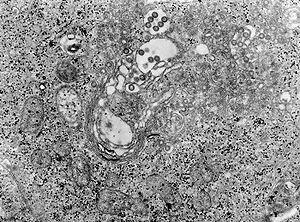Arbovirus
| Arbovirus infection | |
|---|---|
 |
|
| Tissue infected with the Rift Valley fever virus | |
| Classification and external resources | |
| MeSH | D001102 |
Arbovirus is a term used to refer to a group of viruses that are transmitted by arthropod vectors. The word arbovirus is an acronym (ARthropod-BOrne virus). Symptoms of arbovirus infection generally occur 3–15 days after exposure to the virus and last 3 or 4 days. The most common clinical features of infection are fever, headache, and malaise, but encephalitis and hemorrhagic fever may also occur. The word tibovirus (TIck-BOrne virus) is sometimes used to describe viruses transmitted by ticks, a superorder within the arthropods.
Arboviruses were not known to exist until the rise of modern medicine, with the germ theory and an understanding that viruses were distinct from other microorganisms. The connection between arthropods and disease was not postulated until 1881 when Cuban doctor and scientist Carlos Finlay proposed that yellow fever may be transmitted by mosquitoes instead of human contact, a reality that was verified by Major Walter Reed in 1901. The primary vector, Aedes aegypti, had spread globally from the 15th to the 19th centuries as a result of globalization and the slave trade. This geographic spreading caused dengue fever epidemics throughout the 18th and 19th centuries, and later, in 1906, transmission by the Aedes mosquitoes was confirmed, making yellow fever and dengue fever the first two diseases known to be caused by viruses.Thomas Milton Rivers published the first clear description of a virus as distinct from a bacterium in 1927. The discovery of the West Nile virus came in 1937, and has since been found in Culex populations causing epidemics throughout Africa, the Middle East, and Europe. In 1999, the virus was introduced into the Western Hemisphere, sparking a series of epidemics. During the latter half of the 20th century, Dengue fever reemerged as a global disease, with the virus spreading geographically due to urbanization, population growth, increased international travel, and global warming, and continues to cause at least 50 million infections per year, making Dengue fever the most common and clinically important arboviral disease.
...
Wikipedia
